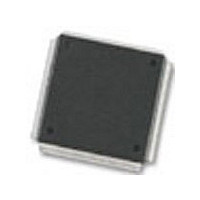MC68376BAMFT20 Freescale Semiconductor, MC68376BAMFT20 Datasheet - Page 118

MC68376BAMFT20
Manufacturer Part Number
MC68376BAMFT20
Description
Manufacturer
Freescale Semiconductor
Datasheet
1.MC68376BAMFT20.pdf
(434 pages)
Specifications of MC68376BAMFT20
Cpu Family
68K/M683xx
Device Core
ColdFire
Device Core Size
32b
Frequency (max)
20MHz
Interface Type
QSPI/SCI
Program Memory Type
ROM
Program Memory Size
8KB
Total Internal Ram Size
7.5KB
# I/os (max)
18
Number Of Timers - General Purpose
2
Operating Supply Voltage (typ)
5V
Operating Supply Voltage (max)
5.25V
Operating Supply Voltage (min)
4.75V
On-chip Adc
16-chx10-bit
Instruction Set Architecture
RISC
Operating Temp Range
-40C to 125C
Operating Temperature Classification
Automotive
Mounting
Surface Mount
Pin Count
160
Package Type
PQFP
Lead Free Status / Rohs Status
Not Compliant
Available stocks
Company
Part Number
Manufacturer
Quantity
Price
Company:
Part Number:
MC68376BAMFT20
Manufacturer:
FREESCAL
Quantity:
245
- Current page: 118 of 434
- Download datasheet (7Mb)
5.7 Reset
5.7.1 Reset Exception Processing
5.7.2 Reset Control Logic
5-40
MOTOROLA
SIZ[1:0] signals reflect bus allocation during show cycles. Only the appropriate portion
of the data bus is valid during the cycle. During a byte write to an internal address, the
portion of the bus that represents the byte that is not written reflects internal bus con-
ditions, and is indeterminate. During a byte write to an external address, the data mul-
tiplexer in the SIM causes the value of the byte that is written to be driven out on both
bytes of the data bus.
Reset occurs when an active low logic level on the RESET pin is clocked into the SIM.
The RESET input is synchronized to the system clock. If there is no clock when
RESET is asserted, reset does not occur until the clock starts. Resets are clocked to
allow completion of write cycles in progress at the time RESET is asserted.
Reset procedures handle system initialization and recovery from catastrophic failure.
The MCU performs resets with a combination of hardware and software. The SIM
determines whether a reset is valid, asserts control signals, performs basic system
configuration and boot ROM selection based on hardware mode-select inputs, then
passes control to the CPU32.
The CPU32 processes resets as a type of asynchronous exception. An exception is
an event that preempts normal processing, and can be caused by internal or external
events. Exception processing makes the transition from normal instruction execution
to execution of a routine that deals with an exception. Each exception has an assigned
vector that points to an associated handler routine. These vectors are stored in the
exception vector table. The exception vector table consists of 256 four-byte vectors
and occupies 1024 bytes of address space. The exception vector table can be relocat-
ed in memory by changing its base address in the vector base register (VBR). The
CPU32 uses vector numbers to calculate displacement into the table. Refer to 4.9 Ex-
ception Processing for more information.
Reset is the highest-priority CPU32 exception. Unlike all other exceptions, a reset oc-
curs at the end of a bus cycle, and not at an instruction boundary. Handling resets in
this way prevents write cycles in progress at the time the reset signal is asserted from
being corrupted. However, any processing in progress is aborted by the reset excep-
tion and cannot be restarted. Only essential reset tasks are performed during excep-
tion processing. Other initialization tasks must be accomplished by the exception
handler routine. Refer to 5.7.9 Reset Processing Summary for details on exception
processing.
SIM reset control logic determines the cause of a reset, synchronizes reset assertion
if necessary to the completion of the current bus cycle, and asserts the appropriate re-
set lines. Reset control logic can drive four different internal signals:
SYSTEM INTEGRATION MODULE
USER’S MANUAL
MC68336/376
Related parts for MC68376BAMFT20
Image
Part Number
Description
Manufacturer
Datasheet
Request
R
Part Number:
Description:
Manufacturer:
Freescale Semiconductor, Inc
Datasheet:
Part Number:
Description:
Manufacturer:
Freescale Semiconductor, Inc
Datasheet:
Part Number:
Description:
Manufacturer:
Freescale Semiconductor, Inc
Datasheet:
Part Number:
Description:
Manufacturer:
Freescale Semiconductor, Inc
Datasheet:
Part Number:
Description:
Manufacturer:
Freescale Semiconductor, Inc
Datasheet:
Part Number:
Description:
Manufacturer:
Freescale Semiconductor, Inc
Datasheet:
Part Number:
Description:
Manufacturer:
Freescale Semiconductor, Inc
Datasheet:
Part Number:
Description:
Manufacturer:
Freescale Semiconductor, Inc
Datasheet:
Part Number:
Description:
Manufacturer:
Freescale Semiconductor, Inc
Datasheet:
Part Number:
Description:
Manufacturer:
Freescale Semiconductor, Inc
Datasheet:
Part Number:
Description:
Manufacturer:
Freescale Semiconductor, Inc
Datasheet:
Part Number:
Description:
Manufacturer:
Freescale Semiconductor, Inc
Datasheet:
Part Number:
Description:
Manufacturer:
Freescale Semiconductor, Inc
Datasheet:
Part Number:
Description:
Manufacturer:
Freescale Semiconductor, Inc
Datasheet:
Part Number:
Description:
Manufacturer:
Freescale Semiconductor, Inc
Datasheet:











